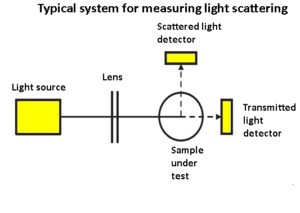Most people assume the sky is blue because through a process of refraction we see the higher-frequency, shorter-wavelength end of the spectrum. This explanation is incorrect. For one thing, if the entire sky is blue, what happened to the rest of the spectrum? It’s complicated.
In actuality, the blue appearance of the sky and yellow appearance of the sun (red at sunrise and sunset) is caused by an effect known as Raleigh scattering. Viewed from outer space, the sun is white and the sky is black. Inside the earth’s atmosphere, the operative concept is Raleigh Scattering, first described by Lord Rayleigh, also renowned for Rayleigh fading and Rayleigh distribution.
Rayleigh scattering happens when electromagnetic radiation such as light encounters particles that are much smaller than its wavelength. Accordingly, the phenomenon is wavelength (and hence frequency) dependent. For example, sunlight has a wavelength of about 500 nm on average. The typical length of a nitrogen or oxygen molecule is about 300 pm. So the wavelength of visible light is more than 1,000 times larger than the size of the particles scattering it. Thus it might seem odd that particles that are super-small compared to the wavelength of visible light would be able to have any impact on the trajectory of the photons hitting them. The cause of the interaction is electromagnetic effects.
Specifically, the atmospheric particles become polarized and the oscillating electrical field associated with the particular wavelength causes that size particle to move at the same frequency. The radiation at the specific frequency appears as visible, diffuse light. That is the reason for the blue appearance of the sky and the yellow or red (white minus blue) apparent coloration of the sun.
 Because the sun’s image passes through a greater quantity of air particles when the sun is close to the horizon, its highly saturated low-frequency red component becomes more intense. When this light illuminates distant cloud formations, brilliant sunsets or sunrises are the product. Along with the blue sky on a clear day, they are the result of Rayleigh scattering.
Because the sun’s image passes through a greater quantity of air particles when the sun is close to the horizon, its highly saturated low-frequency red component becomes more intense. When this light illuminates distant cloud formations, brilliant sunsets or sunrises are the product. Along with the blue sky on a clear day, they are the result of Rayleigh scattering.
Rayleigh scattering measurements are more than just an academic exercise. Scattering effects, Rayleigh and otherwise, can impact the operation of light-based sensors such as lidar (for Light Detection and Ranging) which uses the time-of-flight of a laser beam to gauge distances to a target and sometimes the relative velocity of the target to the lidar platform. It looks as though lidar sensors will play a key role in autonomous vehicle technology by helping the vehicle understand its environment and the likely paths of objects around it. So researchers have become interested in characterizing the scattering effects that automotive lidar is likely to encounter.
Rayleigh scattering applies to particles that are small with respect to wavelengths of light. Scattering by particles similar to, or larger than, the wavelength of light is typically described by other methods including the Mie theory. To make the measurement theory slightly more complicated, some elements will also absorb specific light wavelengths rather than scatter them. All these effects are potentially operative in the earth’s atmosphere.
There are a variety of specialized instruments available for measuring the scattering effects of different media. Most of them, however, use the same basic principle of operation. They point a reference light source at a sample under test and employ two detectors to monitor both the transmitted and scattered light. The instrument typically contains a microcomputer that calculates the ratio of the signals from the reflected and transmitted light detectors. This ratio technique corrects for interferences from color and/or light absorbing materials and compensates for operational factors such as fluctuations in lamp intensity.

Leave a Reply
You must be logged in to post a comment.